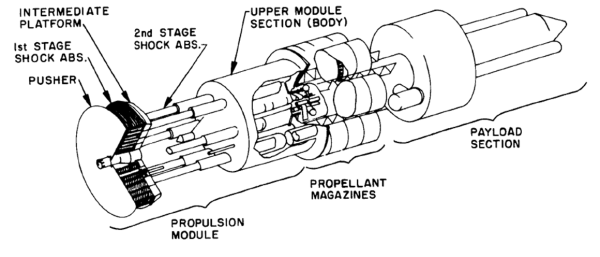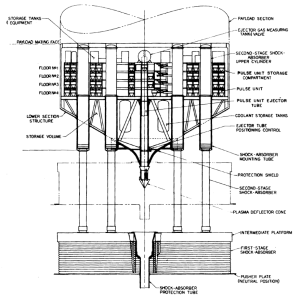The launch of the Atomic Age was marked by a belief that nuclear power would solve all of humanity’s problems on Earth and beyond.
Harnessed atomic energy would be “too cheap to meter” and power every home, car, and aircraft. Nuclear-powered irrigation systems and desalination plants would put a permanent end to global hunger and thirst, ushering in an era of peace and plenty.

The vision also went far beyond these controlled-reaction schemes: the atomic bomb was supposed to render all other explosives obsolete.
Teams involved in Operation Plowshare suggested using nukes for everything from widening the Panama Canal to excavating mountain passes and helping mine natural resources. A proposed new sea-level waterway through Nicaragua, to be carved out using nukes, was nicknamed the Pan-Atomic Canal. There was even a proposal by the Lawrence Livermore National Laboratory to blast deep holes (also using nukes) into which nuclear waste would be disposed.
Beyond these terrestrial applications, atomic energy would take us not just to the moon, but deeper into (and perhaps even beyond) our solar system. It would accomplish this (inter)stellar feat not through controlled reactions, but by sequentially detonating hundreds of powerful thermonuclear devices both on Earth and in space.
Commissioned to study nuclear pulse propulsion in the the 1950s, Project Orion aimed to reach Mars by 1965 and Saturn by 1970. The premise was simple: a series of semi-controlled nuclear explosions would launch and accelerate a spacecraft into and beyond orbit. The nukes would be ejected out the back and detonated. A “pusher plate” behind the vehicle would help absorb shocks and keep passengers safe as they were propelled into space, one bomb blast at a time.

“The propellant is vaporized into a jet of plasma by the bomb,” explains theoretical physicist and mathematician Freeman Dyson. “In contrast to a rocket, which pushes the propellant away from the ship, Orion pushes the ship away from the propellant – by ejecting slow-moving propellant, igniting the bomb and then bouncing some of the resulting fast-moving propellant off the bottom of the ship.”
The proposed craft itself would be a massive and luxurious affair hosting hundreds of scientists, astronauts, and crew members, not the cramped nuts-and-bolts designs we associate with spaceflight today. It was calculated that it would take about 600 detonations, totaling 100 megatons, to boost a generous 20-story spaceship into a 300-mile Earth orbit. Ambitious initial designs called for a 4000-ton ship boosted by 2600 bombs, able to send a 600-ton payload into space.
In theory, detonating one bomb every three 3 minutes for 10 days would make it possible to propel an interstellar spacecraft to 7% of the speed of light, letting it reach the nearest star in about 50 years. In practice, smaller-scale tests (now declassified) show non-nuclear prototypes in action:
Thanks to the fuel efficiency of this approach, and the general zeal of the era, Orion project designers were not particularly concerned with minimization or, really, playing it safe (or small) in any way. If anything, NASA was simply at a loss for what to do with so much payload capacity, which far exceeded the demands of any of its planned space missions at the time.
However, there were some concerns about the secondary effects of this bomb-based propulsion system.

One problem, of course, was fallout. Any land-based launches would directly create problems on Earth, but even using conventional rocket fuel to get to space would create effects as the fallout made its way back into the atmosphere over time. A single launch, it was estimated, would indirectly sicken and kill from one to ten people on Earth.
There were further concerns that the pusher plate might not survive the repeated explosions. Timing and trajectories also had to be perfect and were seen as potentially hard to manage, since the detonations were to take place outside of the craft in open (air or) space.
The Partial Nuclear Test Ban Treaty of 1963 and a general pivot to focus on a near-Earth moon mission largely put an end to the Orion project, but the idea of using explosive nuclear power has been revived in other forms, including fusion and fission pellets (employing, for instance, antimatter catalyzed nuclear pulse propulsion units).
Smaller sequences of explosions would allow for more human-tolerable acceleration for manned missions. This approach would also address concerns about safety and flight control.
For non-manned missions: heavy explosion-fueled crafts could be useful in emergency situations, like intercepting, detonating and scattering the remains of asteroids on a collision course with Earth. Indeed, as George Dyson argues, this may be the only off-the-shelf technology we have for such extreme cases, creating a good reason for NASA to keep Project Orion designs and technology on hand.
Project Orion has also left its imprint on science fiction books, TV shows, and films. The mini-series Ascension, inspired in part by the project, is set in the present but posits an intergenerational crew of colonists, supposedly sent on a secret deep space mission launched in the 1960s. In the original Star Trek, the crew find an old ship powered by “Orion-class nuclear pulse engine.” Arthur C. Clarke considered something similar to fuel his fictional craft Discovery in 2001: A Space Odyssey.

Today, while conventional rocket fuel is the go-to method for getting out of the planet’s atmosphere, there is still a place for nuclear power, just not on the explosive scale at which it was once imagined. Current missions often employ small fission systems or radioactive decay, generating heat that can be converted to electricity in a controlled fashion.
The famously tenacious Curiosity rover is powered by a radioisotope thermoelectric generator (RTG), producing electricity from the heat of radioactive decay. Launched in 2011, this robotic explorer has far exceeded its mission-specified timeline and is still roaming Mars and relaying its findings to Earth, thanks in no small part to extreme dreamers of the nuclear era.




Comments (5)
Share
If I remember correctly, the device used to expel the nuclear fuel in the Orion project was based on a Coke vending machine.
I may have read the same story. Coca-Cola engineers were consulted for the project, and the micro-nukes were canister-shaped, like Coke cans.
Atomic Coke cans … it doesn’t get much stranger than that.
People have also advocated using nuclear weapons to break up tropical hurricanes, which prompted NOAA to write a formal response as to why we don’t want to do this.
“Apart from the fact that this might not even alter the storm, this approach neglects the problem that the released radioactive fallout would fairly quickly move with the tradewinds to affect land areas and cause devastating environmental problems. Needless to say, this is not a good idea.”
(http://www.aoml.noaa.gov/hrd/tcfaq/C5c.html)
Do it now
Gгeat post.